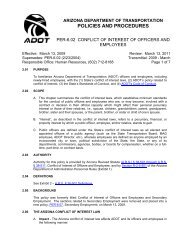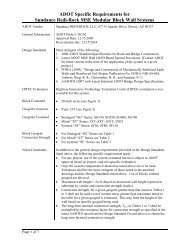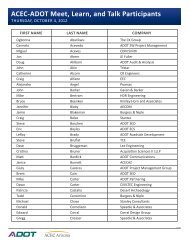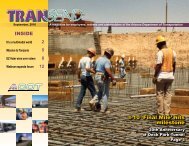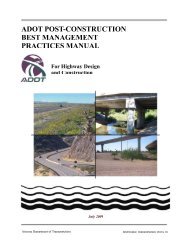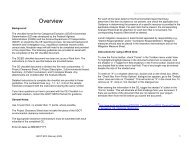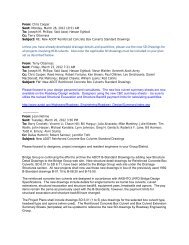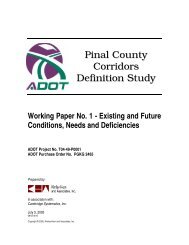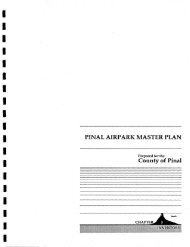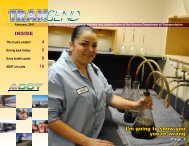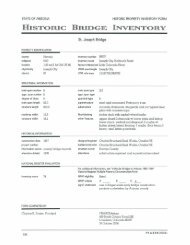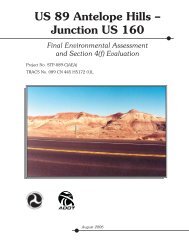I-10 Twin Peaks Traffic Interchange, Environmental Assessment
I-10 Twin Peaks Traffic Interchange, Environmental Assessment
I-10 Twin Peaks Traffic Interchange, Environmental Assessment
You also want an ePaper? Increase the reach of your titles
YUMPU automatically turns print PDFs into web optimized ePapers that Google loves.
Affected Environment and <strong>Environmental</strong> Impacts October 2005<br />
STAMINA is a traffic noise prediction model developed by FHWA that utilizes<br />
site-specific information including traffic volume, speed, vehicle classification<br />
data, roadway lane configuration, and site acoustical characteristics to predict<br />
peak-hour traffic noise at selected receiver locations.<br />
Table 4-7. <strong>Traffic</strong> Noise Monitoring Results<br />
Monitoring Location and (Beginning Times)<br />
Location 1 South Side of Linda Vista Boulevard, East of<br />
Hartman Lane (7:15 – 7:36 AM)<br />
Location 2 West of I-<strong>10</strong> at Linda Vista Boulevard (6:56 –<br />
7:20 AM)<br />
Location 3 South Side of <strong>Twin</strong> <strong>Peaks</strong> Road, West of Palm<br />
Canyon Drive (7:52 – 8:07 AM)<br />
Location 4 West Side of <strong>Twin</strong> <strong>Peaks</strong> Elementary School<br />
(5:21 – 5:42 PM)<br />
Location 5 East of I-<strong>10</strong> at Camino de Mañana Road (4:27<br />
– 4:50 PM)<br />
Location 6 Mountain View High School/Arthur Pack Golf<br />
Course (4:08 – 4:29 PM)<br />
Location 7 North Side of <strong>Twin</strong> <strong>Peaks</strong> Road, West of<br />
Sunflower Ridge Road (5:<strong>10</strong> – 5:32 PM)<br />
Noise Level (dBA)<br />
(Highest Reading Per Site)<br />
To ensure that the results of STAMINA accurately reflected actual conditions,<br />
traffic (volumes and numbers of medium and heavy trucks) and site data (location<br />
and height of walls) were also collected during field noise measurements. These<br />
field conditions were entered in the computer model and the noise levels predicted<br />
by the model were compared to those measured in the field. This adjustment<br />
process identifies minor modifications in model data entries that are used to more<br />
accurately predict field conditions. Model predicted values were within 2 dBA of<br />
those values measured in the field, demonstrating that the model predicted actual<br />
monitored conditions well.<br />
Modeling of Existing Conditions<br />
Noise levels for current (2004) conditions were modeled at sensitive receivers in<br />
the project area. This was done to determine where noise impacts currently exist<br />
and to establish the baseline from which a substantial increase in noise levels is<br />
determined. <strong>Traffic</strong> data necessary for modeling were obtained from several<br />
different sources. The primary source of information was the <strong>Traffic</strong> Report<br />
prepared for this project. The report provided traffic counts, speeds, peak hour, and<br />
vehicle classification information (numbers of trucks, cars, etc.) for most of the<br />
streets in the study area. The project route was broken into multiple segments<br />
Interstate <strong>10</strong> <strong>Traffic</strong> <strong>Interchange</strong> at<br />
<strong>Twin</strong> <strong>Peaks</strong>/Linda Vista<br />
4-50<br />
68<br />
73<br />
57<br />
55<br />
69<br />
56<br />
63<br />
Project No.: NH-0<strong>10</strong>-D (AIW)<br />
TRACS No.: <strong>10</strong> PM 236 H5838 01D



